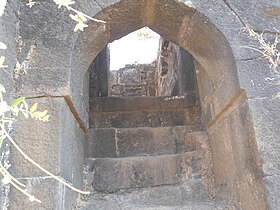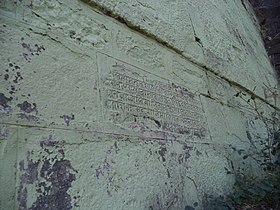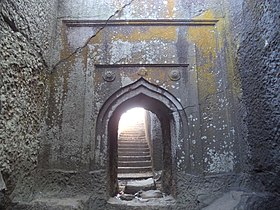Ramsej Fort
This article needs additional citations for verification. (September 2009) |
| Ramshej Fort | |
|---|---|
| Nashik, Maharashtra, India | |
 Ramshej fort from base village | |
| Coordinates | 20°06′44″N 73°46′02″E / 20.112195°N 73.767354°E |
| Type | Fort |
| Height | 3200 feet |
| Site information | |
| Owner | Govt. of India |
| Controlled by |
|
| Open to the public | Yes |
| Condition | Ruins |
| Site history | |
| Materials | Stone |
| Garrison information | |
| Past commanders | Suryaji Jadhav |
Ramsej or Ramshej Fort (Ramshej - Rama's bed) is a small fort located 10 kilometres (6.2 mi) north-west of Nashik, in the Indian state of Maharashtra. Lord Rama stayed in the fort for a short time while traveling to Sri Lanka.[1] The fort is located on the Nashik-Vapi route.
History[edit]
Ramsej Fort is an historic fort in India.
History[edit]
The fort was used in the fight against the Mughal Empire that lasted for six and a half years.[2] The fort's first Killedar (Fort commander) was Suryaji Jadhav. He was transferred after five and a half years, as per the rotation policy of the Maratha Empire. In 1682 Aurangzeb sent Sahabuddin Khan to conquer the fort. Shahbuddin Khan, with his 40,000 man army and artillery, vowed to capture the fort within a few hours, but the 600 Maratha soldiers in the fort held their posts and pushed the forces back for many months with a fierce array of slingshots, lit haystacks, and huge stones - even though they had no cannons. Mughal artillery managed to break the fort walls one evening. They assumed that the fort would be captured easily. However, the soldiers worked all night to rebuild the broken section of the wall, much to the despair and awe of the Mughals.
The inability of the artillery to capture the fort made Aurangzeb very frustrated and uneasy. He raised a wooden platform to storm the fort. Chatrapati Shivaji Maharaj and his son Chatrapati Sambhaji Maharaj had a policy of keeping a healthy supply of ammunition in the fort, even though it had no cannons or guns. Ramsej was no exception and, even though it did not have cannons, its ammunition was sufficient. The Fort Commander came up with the idea to use amply-available animal skin and wood to make wooden cannons. Coupled with the ammunition already available in the fort, these wooden cannons inflicted heavy damage to the Mughal army. The retaliation from the Marathas was so strong that Aurangzeb left the command to Bahadurkhar Khan Kokaltash and fled to Junnar.
Bahadurkhan tried to capture the fort by fooling Marathas into believing that the Mughals were preparing for a full-fledged frontal assault, while his real plan was to send 200 of his best troops to climb the steep cliff on the rear side of the fort. The Maratha commander became aware of the plan and allowed those soldiers to climb the rope. While they were climbing, he cut the rope, dooming the Mughal soldiers. Bahadurkhan was distraught and found that Marathas were receiving secret supplies from nearby forts. He carefully blocked all the paths to nearby Maratha forts, creating a dire food shortage. Seeing the situation, Maratha King Sambhaji acted quickly by sending his sardars - Rupaji Bhosle and Manaji - with 8,000 extra soldiers and supplies.
They tried to break through the Mughal line but were unable to supply the fort. Sambhaji worried greatly that his fiercely loyal and brave warriors were fighting without food. However, the weather supported the Marathas and due to severe weather conditions, Bahadurkhan relaxed his encirclement for one day. This enabled Rupaji and Manaji to deliver enough supplies for six more months. Bahadurkhan then tried to win the fort with the help of a 'mantrik' believing that the Marathas had ghosts under their control.
The Marathas again fooled him as the Mantrik was as a Maratha soldier in disguise who led the Mughal army to a deadly ambush. Bahadurkhan and Mughals fled the deadly ambush and several Mughals were killed in this surprise attack. Bahadurkhan was unable to siege the fort. Finally, he burnt the wooden platform and left the battle. Aurangzeb sent Kasim Khan Kirmani to lead the battle[3] and the Mughals ultimately conquered Ramshej Fort.
Ramsej was one of the forts that surrendered to the British Army in 1818 after the fall of Trymbakgad fort.[4] Captain Briggs reported 8 guns, 9 small cannons called jamburasand 21 jingals there.
Geography[edit]
The Fort is located on a high tableland with escarpments on all sides. Steps on the eastern side of the fort lead to the entrance gate. A temple of Lord Ram is at the entrance. A water cistern near the temple holds potable water.
On the eastern side of the fort is the main gate, which is chiseled from the parent rock. Rock-cut water cisterns are present in the fort. The hidden entrance gate on the eastern side of the fort leads to the path to Bhorgad fort which is about 3.21 km. (two miles) north-west of Ramsej
Gallery[edit]
See also[edit]
- Siege of Ramsej
- List of forts in Maharashtra
- List of forts in India
- Sambhaji
- Marathi People
- List of Maratha dynasties and states
- Maratha War of Independence
- Battles involving the Maratha Empire
- Maratha Army
- Maratha titles
- Military history of India
- List of people involved in the Maratha Empire
References[edit]
- ↑ "Ramshej Fort,Forts Maharashtra". Forts of Maharashtra. 7 July 2019. Retrieved 14 January 2022.
- ↑ "Siege of Ramsej: Aurangzeb was frustrated for years".
- ↑ "Ramshej, Sahyadri,Shivaji,Trekking,Marathi,Maharastra". trekshitiz.com. Archived from the original on 28 August 2012.
- ↑ "Nasik District Gazetteers". Cultural.maharashtra.gov.in. 31 March 1965. Retrieved 12 August 2022.








